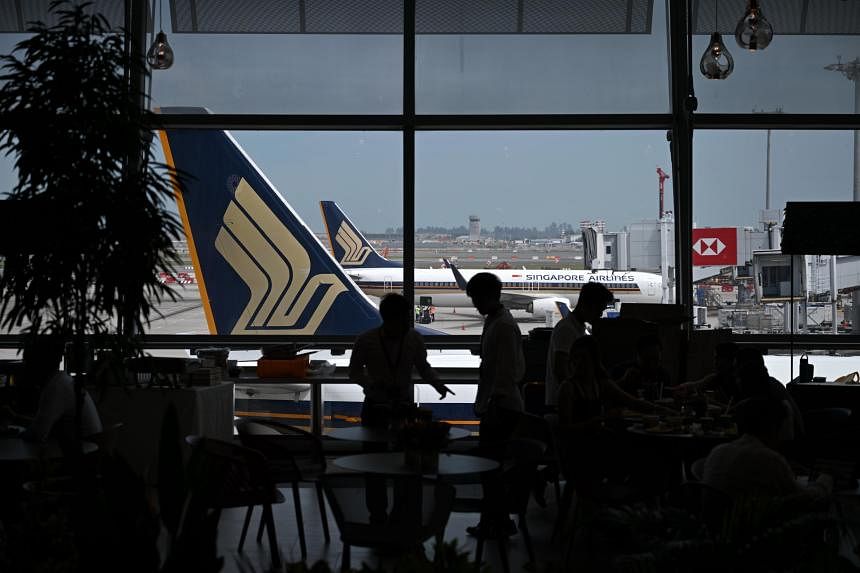SINGAPORE – The aviation industry as a whole, and not just Singapore Airlines (SIA), has priced airfares high as air travel continues to recover from the Covid-19 pandemic, said the national carrier’s chief executive Goh Choon Phong.
Asked whether prices for flight tickets have peaked, he pointed to softening passenger yields – a proxy for airfares – as rival airlines have added more capacity.
He said SIA does not set its prices in isolation. Instead, it looks at what competitors offering similar products are doing – comparing similar non-stop flights, for instance – and ensures that the price disparity is not too big.
“We have always said that pricing is a function of demand and supply, and it is, even during this whole Covid-19 period… Going forward, it’s the same,” he told the media on Wednesday during a wide-ranging interview after his company posted record earnings for the first half of its financial year from April to September.
For the first half of financial year 2023/24, SIA Group’s passenger yield was 10.8 cents per passenger-km, down from 11.8 cents for the whole of financial year 2022/23 and 13.6 cents for FY21/22. Passenger yield is a measure representing the average fare paid by a passenger for each kilometre flown.
In comparison, the group’s passenger yield for financial year 2019/20 was 9.1 cents per passenger-km.
SIA Group, which includes low-cost carrier Scoot, reported a first-half net profit of $1.44 billion, up 55 per cent from $927 million for the same period a year ago.
On Tuesday, the group said demand for air travel is expected to remain healthy for the remaining two quarters ending in March 2024.
But it said significant capacity restoration across the industry, especially in the Asia-Pacific region, could put pressure on passenger yields.
At an earnings briefing on Wednesday, SIA chief commercial officer Lee Lik Hsin reiterated that increasing competition has put pressure on yields, and this is expected to continue into the third and fourth quarter of the financial year.
“We are not making any projections on where (yields) might finally land, but we will respond to the market situation as necessary,” he added.
Meanwhile, SIA is ramping up its own flight capacity, which is expected to reach around 92 per cent of pre-pandemic levels in December and recover fully some time between April 2024 and March 2025.
Mr Lee said a combination of factors is holding SIA back from fully restoring capacity in the short term.
He noted that SIA has restructured its network and stopped flying to some destinations such as Wellington in New Zealand, which translates to a lower capacity than before.
Some 370,000 discounted SIA, Scoot tickets to go on sale in November
SIA and Scoot to resume flights from Changi to five cities in China from Nov 26
Capacity to China, which is now at about three-quarters of pre-pandemic levels, has also not been fully restored as demand from there has not fully recovered.
Mr Goh said there has been more demand for flights from Singapore to China after the relaxation of border controls in early 2023 and visa requirements in July, but traffic from China to Singapore “isn’t quite at the level that we saw before”.
He believes this traffic will come back at some point and SIA is poised to recapture it, despite the delay in the delivery of its new Boeing 777-9s until 2025.
SIA bought the first batch of the aircraft in 2017, and the airline began developing new cabin concepts for it in 2018. The carrier was originally due to receive its first Boeing 777-9 plane in 2021, but this was then pushed back to 2023.
Mr Goh said the company has taken into account the supply disruptions that have continued to plague plane manufacturers.
“We were really hoping for our new (cabin) products to be launched this year, and we truly believe that those will be industry-leading, but we have to delay it by two years,” he said.
“Even then… we do believe that in two years’ time when we launch it, based on whatever that’s been announced so far, we will still be ahead.”
Mr Goh said SIA’s strategy during the pandemic was to be the first off the blocks as borders reopened. He believes it is still ahead of the pack when compared with other Asian carriers.
“Of course, this first-mover advantage over time would diminish,” he said, pointing to the use of artificial intelligence to cut response time to customers, for instance, as one way that SIA is trying to maintain its edge.
Speaking to the media at a separate event on Thursday, Association of Asia-Pacific Airlines director-general Subhas Menon echoed Mr Goh’s comments about airfares, noting that prices should come down relative to demand as flight capacity continues to pick up.
Asked why fares have remained high in 2023, Mr Menon said capacity has not recovered as much as it should have, and the main reason for this is supply chain issues.
He added: “If some airlines are able to put back all of their flights… while others are unable to do so, then the ones that have got flights everywhere probably can command a higher fare.”
On passenger demand in China, Mr Menon said the rebound in traffic is still subdued. He cited macroeconomic factors there, including the property crisis, rising cost of living, and high youth unemployment.
Securing take-off and landing slots in China has also been a problem, but Mr Menon said he does not believe this will be a major stumbling block for airlines in the Asia-Pacific.
SIA posts record $1.44 billion net profit for first half
SIA to step up flights to key markets from March 2024 amid strong demand
Join ST’s WhatsApp Channel and get the latest news and must-reads.
p.st_telegram_boilerplate:before {
display: inline-block;
content: ” “;
border-radius: 6px;
height: 6px;
width: 6px;
background-color: #12239a;
margin-left: 0px;
margin-right: 13px;
}
a.st_boilerplate {
font-family: “SelaneWebSTForty”, Georgia, “Times New Roman”, Times, serif;
}


